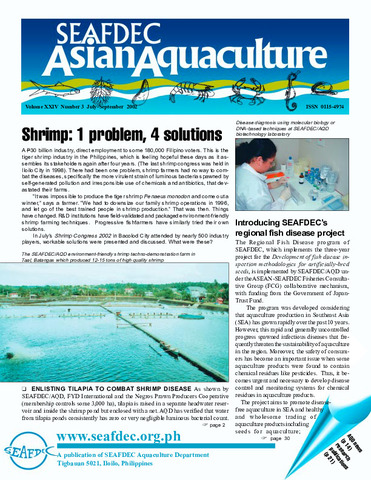Nursery and grow-out operation and management of Penaeus monodon (Fabricius)
- Global styles
- MLA
- Vancouver
- Elsevier - Harvard
- APA
- Help

Date
1988Author
Page views
7,230ASFA keyword
stocking density 
fish handling
shrimp culture
feeds
extensive aquaculture
fry
husbandry diseases
pond culture
disease control
survival
fertilization
aquaculture systems
aquaculture economics
intensive aquaculture
aquaculture facilities
water management
feeding experiments
parasitic diseases
aquaculture techniques
crustacean larvae

fish handling

shrimp culture

feeds

extensive aquaculture

fry

husbandry diseases

pond culture

disease control

survival

fertilization

aquaculture systems

aquaculture economics

intensive aquaculture

aquaculture facilities

water management

feeding experiments

parasitic diseases

aquaculture techniques

crustacean larvae

AGROVOC keyword
Taxonomic term
Metadata
Show full item record
Share
Abstract
The results of research on nursery and grow-out rearing of prawn conducted by the SEAFDEC Aquaculture Department for over a decade are reviewed. Different rearing facilities designed to accommodate hatchery-produced prawn fry are presented with corresponding data on growth, survival and production. Studies on stocking density, fertilization/natural food production, water management, feeds and feeding schemes and harvest/post-harvest handling are evaluated and viable technology identified. Diseases, pests and predators and other factors considered as production constraints are also mentioned.
The success in hatchery operation for prawn coupled by the gradual emergence of nursery and grow-out rearing technology have triggered off a technology-dependent prawn industry. When SEAFDEC AQD was established in 1973, there were very few commercial prawn monoculture ventures in the country. Prawn pond production was mostly an incidental crop in milkfish culture. At present, various prawn grow-out techniques ranging from extensive, semi-intensive and intensive culture systems are in practice. SEAFDEC AQD focused its research on the extensive and semi-intensive culture systems which are within the reach of most farmers in contrast to the intensive system that is highly capital-intensive.
There have been much work done in nursery and grow-out operations, but much remains to be done in research, among which are the development of nutritionally-efficient and low-cost feed, control of diseases, etc.
Suggested Citation
Corre, K. G. (1988). Nursery and grow-out operation and management of Penaeus monodon (Fabricius). In J. V. Juario & L. V. Benitez (Eds.), Perspectives in Aquaculture Development in Southeast Asia and Japan: Contributions of the SEAFDEC Aquaculture Department. Proceedings of the Seminar on Aquaculture Development in Southeast Asia, 8-12 September 1987, Iloilo City, Philippines. (pp. 249-267). Tigbauan, Iloilo, Philippines: SEAFDEC, Aquaculture Department.
Type
Conference paperISBN
971851113XCollections
- ADSEA '87 [20]
Related items
Showing items related by title, author, creator and subject.
-
Current status of shrimp farming and diseases in Cambodia
Lang, Ouch; Sothea, Mey (Aquaculture Department, Southeast Asian Fisheries Development Center, 2016)The farming of penaeid shrimps in Cambodia began in 1989 and has significantly expanded since 1991. Shrimp cultivation has been carried out in the four coastal provinces, i.e. Kampot, Kep, Preah Sihanouk Ville, and Koh ... -
Shrimp: 1 problem, 4 solutions
Castaños, Milagros T.; Southeast Asian Fisheries Development Center, Aquaculture Department (Aquaculture Department, Southeast Asian Fisheries Development Center, 2002) -
Bacterial diseases in tiger shrimp culture in the Philippines
Lavilla-Pitogo, Celia R.; de la Peña, Leobert D. (Aquaculture Department, Southeast Asian Fisheries Development Center, 1998)





